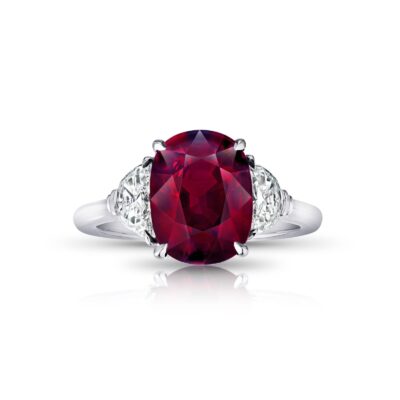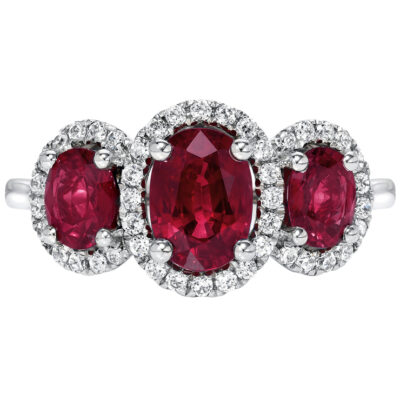Ruby Engagement Rings
Ruby deposits are found as far afield as Myanmar (Burma), Afghanistan, Madagascar, Tanzania and Greenland. Named from the Latin word for ‘red’, the ruby was the most valued gemstone in the ancient world. In Sanskrit, it is called ratnaraj, or “king of precious stones”, and there are records of rubies being traded on the North Silk Road of China as long ago as 200BC. 
Scoring 9 on the Mohs hardness scale, ruby is hard enough to withstand everyday wear and tear (only diamond at 10 scores higher), and until the 1930s, ruby was the most popular gemstone for engagement rings. So if you’re interested in sourcing a ruby, what are the key things you should look out for?
The Finest Rubies Are A Vibrant Red

The colour of a ruby is perhaps the first thing to consider, and a major factor in determining its value. Like sapphire, ruby is formed from a mineral called corundum, but the presence of trace amounts of chromium give it a red colour.Rubies come in hues ranging from orange-red through pure red to purple-red. The best rubies are an intense, vibrant red, with a faint hint of purple, that are neither too dark, nor too light — known in the trade as “pigeon’s blood” red.
Flawless Rubies Are Exceptionally Valuable
Clarity is another factor that heavily influences how valuable a ruby is. Most rubies have visible blemishes or inclusions, which can come in many forms: pinpoint or grain crystals; fine fibres of titanium oxide (rutile), known as silk; long thin tubes filled with gas or liquid; feather-like cracks; and various others. The fewer inclusions there are, and the less prominent they are, the rarer and more valuable a ruby is.
Most Rubies Are Heat Treated
It is possible to improve the colour and clarity of rubies by heating them. This technique has been practiced for hundreds of years, and is completely stable (the enhancements are permanent). For this reason heat treatment is very widespread, and you should assume that a ruby has been heated unless you are told otherwise. Unheated rubies tend to trade at a significant premium, and so will normally be supplied with a gemological certificate confirming that there is no evidence of heat treatment.
If It Seems Too Good To Be True, It Probably Is
Aside from heating, there are various other treatments that rubies can be exposed to. These include lead glass filling, flux healing, and beryllium diffusion, all of which disguise problems with a stone’s colour or clarity and in some cases can cause structural weaknesses in the gem. All of these treatments significantly undermine the value of a ruby, and should always be disclosed. If a ruby seems unusually well priced and you can’t see any obvious problems with colour or clarity, then most likely it has been subjected to one or more of these treatments. If you are in any doubt, you should get the stone checked by an independent gemologist — no reputable supplier would object to this request.
Ethical Rubies
At A Star Diamonds we only source rubies that have been produced in a socially and environmentally responsible way, and which we can trace back to mine of origin. The only treatment we accept is heating, and we also offer unheated rubies.
Please feel free to get in touch if you have any questions, or to discuss commissioning your own bespoke design.